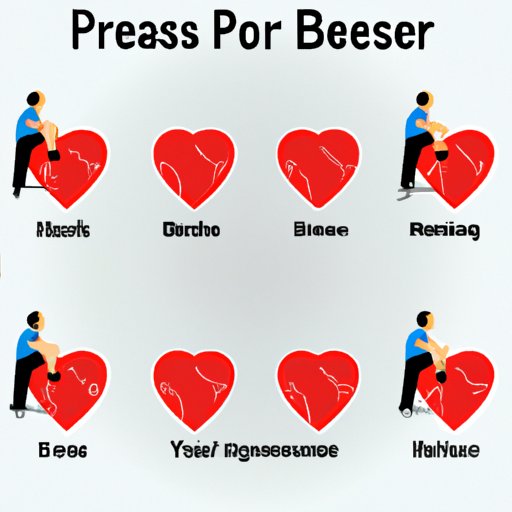Introduction
High blood pressure, also known as hypertension, is a common medical condition in which the force of the blood against the artery walls is too high. This can increase the risk of stroke, heart attack, and other serious health problems. While there is no cure for high blood pressure, there are ways to manage it, such as taking medications, making lifestyle changes, and engaging in regular physical activity. Exercise has been shown to be one of the most effective ways to reduce blood pressure levels and improve overall health.

Examining the Role of Exercise in Reducing Blood Pressure
Regular exercise has many benefits, including reducing stress and improving overall health. Exercise can also help reduce blood pressure by:
- Increasing heart rate and breathing rate.
- Helping the body use oxygen more efficiently.
- Promoting better circulation.
- Strengthening the heart muscle.
There are several types of exercise that can help lower blood pressure, including aerobic exercises (such as walking, jogging, swimming, and cycling) and strength training (such as weight lifting). Regular physical activity can also help reduce stress, which can lead to higher blood pressure levels.

How to Lower Blood Pressure Through Regular Exercise
To get the most out of your exercise routine and lower your blood pressure, you should:
- Establish a regular exercise routine. Aim to exercise at least 30 minutes a day, five days a week. Start slowly and gradually increase the intensity of your workouts over time.
- Choose activities that you enjoy. You don’t have to do the same type of exercise every day. Mix it up and try different activities, such as yoga or Pilates.
- Avoid exercises that could potentially raise your blood pressure, such as isometric exercises like holding a plank. These can cause your blood pressure to spike temporarily.
High Blood Pressure & Exercise: What You Should Know
Before you begin an exercise routine, it is important to understand your current health status and any potential risks. It is also important to work with a doctor or healthcare provider to ensure that the exercises you are doing are safe and appropriate for your individual needs. Your doctor may also suggest medications to help control your blood pressure while you are exercising.
It is also important to monitor your blood pressure levels when you start an exercise program. If your blood pressure is too high, it is best to stop and contact your doctor right away. The American Heart Association recommends checking your blood pressure at least once a month to make sure it is in a healthy range.
Does Exercise Really Help Lower Blood Pressure?
Studies have consistently shown that regular physical activity can reduce both systolic (upper number) and diastolic (lower number) blood pressure readings. In addition, regular exercise can help reduce the risk of stroke and heart attack by strengthening the heart muscle and promoting better circulation.

The Benefits of Exercise for High Blood Pressure
Regular physical activity can offer a variety of benefits for people with high blood pressure, including:
- Improved cardiovascular health, which can help reduce the risk of heart attack and stroke.
- Reduced risk of stroke and heart attack due to improved circulation and strengthened heart muscle.
- Improved quality of life by reducing stress and anxiety.
Exploring the Connection Between Exercise and Blood Pressure Levels
When it comes to understanding the connection between exercise and blood pressure levels, it is important to consider both the immediate and long-term effects. In the short term, exercise can cause a temporary rise in blood pressure, but this usually returns to normal within an hour. Over time, regular physical activity can help reduce blood pressure levels.
In addition, there are several factors that can affect blood pressure levels, such as age, gender, body weight, and stress levels. It is important to keep these factors in mind when developing an exercise routine.
Conclusion
Regular exercise can be an effective way to reduce blood pressure levels and improve overall health. However, it is important to understand your current health status and consult with a doctor before beginning an exercise program. Additionally, it is important to monitor your blood pressure levels regularly and adjust your exercise routine as needed. With the right approach, exercise can be a powerful tool for managing high blood pressure.
For more information about how to effectively manage high blood pressure through exercise, please visit the American Heart Association website at https://www.heart.org/en/health-topics/high-blood-pressure/changes-you-can-make-to-manage-high-blood-pressure/how-physical-activity-can-help-control-high-blood-pressure.


